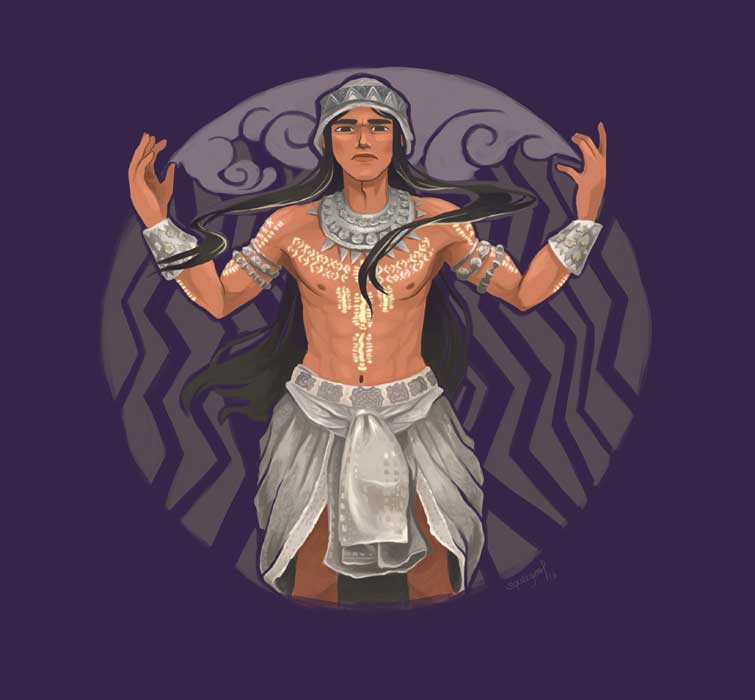Ribung Linti – the god of thunder and lightning. He was believed to be able to control thunder , release bolts of electricity and harness lightning.
There is actually very little known about the lightning deity, but we do know how he was first documented. In 1955, Filipino anthropologist F. Landa Jocano became interested in native folklore. He travelled deep into central Panay with two colleagues collecting folk songs, stories, and riddles. It was during one of those trips to the upland barrios of Lambunao, Maasin, Janiuay, and Calinog in Iloilo that his attention was called to a long and popular tale called Hinilawod – a 28,000-verse epic that takes about three days to chant in its original form, making it one of the longest epics known. Over the course of several weeks they would record the Hinilawod epic and document many other customs and beliefs. In Jocano’s 1958 paper “The Sulod: A Mountain People In Central Panay, Philippines”, we find the only mention of Ribung Linti.

“The Ibabawnun or “Upperworld” is divided into two dominions–one occupied by the male diwata and the other by the female diwata? The most powerful male diwata is called Tungkung Langit. His origin is not known. He merely appeared in this realm one day and proclaimed his power. He is assisted by other less powerful diwata; namely, Bangunbagun, the diwata who regulates cosmic movements; Pahulangkug, the diwata who changes the seasons; Ribung Linti, the diwata of lightning and thunderstorms; Sumalongsong, the diwata of the rivers and seas; Santonil.vo. the diwata of good graces; and Munsad Burulakaw,” the diwata who has direct power over men. The latter is the most respected and feared among the diwata of the Upperworld.”
Nowhere else has there been a mention of this lightning deity. We are not sure of his functions, but we could assume he served to punish those who would displease him, or perhaps even strike against those who are in conflict with the people who give him favour. It is not uncommon for the gods in any mythology to send thunder and lightning to strike the transgressors of their moral laws, or as punishment for acting against the will of their followers.
Ribung Linti literally translates to “thousand lightnings”. Linti still means “lighning” in the Ilongo language, but it has also become known as a very offensive expression of disgust. If one blurts it out, it could be deemed as extremely offensive.
There is apparently a children’s story in the Sulod region of Panay. The dwarfs of the earth spent an entire year building building a ladder out of vines to reach Ibabawnon (Upper World). Their reason for this was to ask the lightning deity to be mindful when he casts lightning, for he sometimes strikes the termite mounds they live in. Impressed by their efforts, Ribung Linti told the dwarfs they should raise little umbrellas (mushrooms) on their homes when the rain comes so he may see them. The dwarfs did exactly as he said which is why we sometimes see mushrooms (“uhong” ) on termite mounds after a thunderstorm.
There is no verifying the validity of this tale as it only appears on one fan blog and in no literature or study. It could simply be a once off story told by a Nanay or Lola – or it might be another section of an epic waiting to be discovered. Who knows?
Even with a lack of documented myths that involve Ribung Linti, the unwavering preservation of these stories over the centuries by the Sulodnon people has cemented the lightning deity in Visayan Mythology forever.
Jordan Clark is a Canadian born descendant of Scottish immigrants living on the homelands of the Lekwungen speaking peoples. His interest in Philippine myth and folklore began in 2004. Finding it difficult to track down resources on the topic, he founded The Aswang Project in 2006. Shortly after, he embarked on a 5 year journey, along with producing partner Cheryl Anne del Rosario, to make the 2011 feature length documentary THE ASWANG PHENOMENON – an exploration of the aswang myth and its effects on Philippine society. In 2015 he directed “The Creatures of Philippine Mythology” web-series, which features 3 folkloric beings from the Philippines – the TIKBALANG, KAPRE and BAKUNAWA. Episodes are available to watch on YouTube. Jordan recently oversaw the editing for the English language release of Ferdinand Blumentritt’s DICCIONARIO MITOLÓGICO DE FILIPINAS (Dictionary of Philippine Mythology) and is working on two more releases with fellow creators scheduled for release later this year. When his nose isn’t in a book, he spends time with his amazing Filipina wife of 20 years and their smart and wonderful teenaged daughter.


